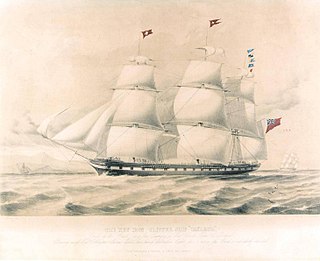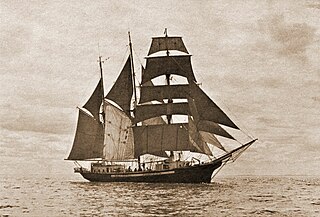
The PS Lady Elgin was a wooden-hulled sidewheel steamship that sank in Lake Michigan off the fledgling town of Port Clinton, Illinois, whose geography is now divided between Highland Park and Highwood, Illinois, after she was rammed in a gale by the schooner Augusta in the early hours of September 8, 1860. The passenger manifest was lost with the collision, but the sinking of Lady Elgin resulted in the loss of about 300 lives in what was called "one of the greatest marine horrors on record". Four years after the disaster, a new rule required sailing vessels to carry running lights. The Lady Elgin disaster remains the greatest loss of life on open water in the history of the Great Lakes.

A sailing ship is a sea-going vessel that uses sails mounted on masts to harness the power of wind and propel the vessel. There is a variety of sail plans that propel sailing ships, employing square-rigged or fore-and-aft sails. Some ships carry square sails on each mast—the brig and full-rigged ship, said to be "ship-rigged" when there are three or more masts. Others carry only fore-and-aft sails on each mast, for instance some schooners. Still others employ a combination of square and fore-and-aft sails, including the barque, barquentine, and brigantine.

A hulk is a ship that is afloat, but incapable of going to sea. Hulk may be used to describe a ship that has been launched but not completed, an abandoned wreck or shell, or to refer to a ship whose propulsion system is no longer maintained, or has been removed altogether. The word hulk also may be used as a verb: a ship is "hulked" to convert it to a hulk. The verb was also applied to crews of Royal Navy ships in dock, who were sent to the receiving ship for accommodation, or "hulked". Hulks have a variety of uses such as housing, prisons, salvage pontoons, gambling sites, naval training, or cargo storage.

Kilkee is a small coastal town in County Clare, Ireland. It is in the parish of Kilkee, formerly Kilfearagh. Kilkee is midway between Kilrush and Doonbeg on the N67 road. The town is popular as a seaside resort. The horseshoe bay is protected from the Atlantic Ocean by the Duggerna Reef.

RMS Tayleur was a full-rigged iron clipper ship chartered by the White Star Line. She was large, fast and technically advanced. She ran aground off Lambay Island and sank, on her maiden voyage, in 1854. Of more than 650 aboard, only 280 survived. She has been described as "the first Titanic".

SS Schiller was a 3,421-ton German ocean liner, one of the largest vessels of her time. Launched in 1873, she plied her trade across the Atlantic Ocean, carrying passengers between New York City and Hamburg for the German Transatlantic Steam Navigation Line. She became notorious on 7 May 1875, while operating on her normal route, when she hit the Retarrier Ledges in the Isles of Scilly, causing her to sink with the loss of most of her crew and passengers, totaling 335 fatalities.

Peter Iredale was a four-masted steel barque that ran ashore October 25, 1906, on the Oregon coast en route to the Columbia River. She was abandoned on Clatsop Spit near Fort Stevens in Warrenton about four miles (6 km) south of the Columbia River channel. Wreckage is still visible, making it a popular tourist attraction as one of the most accessible shipwrecks of the Graveyard of the Pacific.
The Earl of Charlemont was a medium-sized, 878 ton passenger ship, which sank on a voyage to Australia.
Many ships have wrecked in and around San Francisco Bay. For centuries San Francisco Bay, with its strong currents, rocky reefs, and low fog conditions has experienced more than a hundred shipwrecks. Ever since San Francisco Bay was discovered during the land expedition of Gaspar de Portolà in 1769, it has been one of the most popular harbors.

The sailing ship Regina Maris was originally built as the three-masted topsail schooner Regina in 1908. She was a 144-foot (44-meter), wooden, completely fore-and-aft–rigged sailing ship with three masts. She was re-rigged in 1963 as a 148-foot (45-meter) barquentine. Regina Maris could reach a speed of up to 12 knots, especially on a half-wind course or with a fresh back-stay breeze.
The Fulmar was a cargo vessel that sank in the Atlantic Ocean off Kilkee, County Clare, Ireland, on the night of 30 January 1886. At the time of the disaster the ship was transporting coal from Troon in Ayrshire, Scotland to Limerick city in Ireland. Occurring 50 years to the day of the sinking of the Intrinsic, the ship is one of four that have perished with loss of life off the coast of the small town of Kilkee, the others being the Edmond, and the Inishtrahull.
The Inishtrahull was a passenger cargo vessel that sank off the coast of Kilkee, County Clare between 28 and 29 December 1894. After leaving Glasgow, Scotland with a consignment of coal for Limerick city on 27 December 1894, the ship ran into difficulty somewhere near Kilkee and foundered due to the heavy gales reported along the west coast of Ireland in late December of that year. This was confirmed on 3 January 1895 when a section of a port bow marked "Glasgow" was picked up near Kilkee.

STV Astrid was a 41.90-metre long tall ship that was built in 1918 in the Netherlands as a lugger and originally named W.U.T.A., short for Wacht Uw Tijd Af meaning "Bide Your Time". She was later transferred to Swedish ownership, renamed Astrid and sailed on the Baltic Sea until 1975. She then sailed under a Lebanese flag and was allegedly used for drug smuggling. After being found burnt out on the coast of England in the early 1980s, she was overhauled and used as a sailing training vessel. She was based in Weymouth, Dorset, United Kingdom and was informally known as "Weymouth's vessel".

The SV Argo was an American wooden sailing vessel (SV) designed for the trans-Atlantic Packet trade. William Whitlock, Jr acquired the ship for his Havre-Whitlock Line, which regularly scheduled round trips three times a year from New York City to Le Havre, France.
Sovereign was launched at Newcastle in 1789. She traded between London and South Carolina and then as a transport. In 1802 she became a Guineaman, i.e., a slave ship, in the triangular trade in ensalved people. She wrecked on 22 January 1804 as she was returning from the West Indies where she had landed her captives at Trinidad.
This glossary of nautical terms is an alphabetical listing of terms and expressions connected with ships, shipping, seamanship and navigation on water. Some remain current, while many date from the 17th to 19th centuries. The word nautical derives from the Latin nauticus, from Greek nautikos, from nautēs: "sailor", from naus: "ship".

The wooden sailing ship Oneida was a merchant vessel built for the New York to Le Havre, France packet trade. It was owned by John J. Boyd and Edward Hincken, and it operated on the Havre Second Line.










